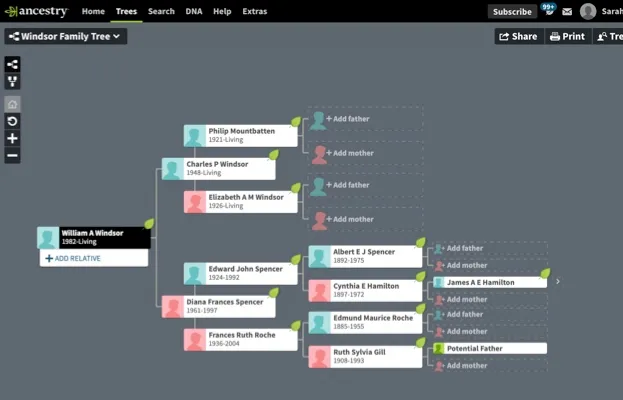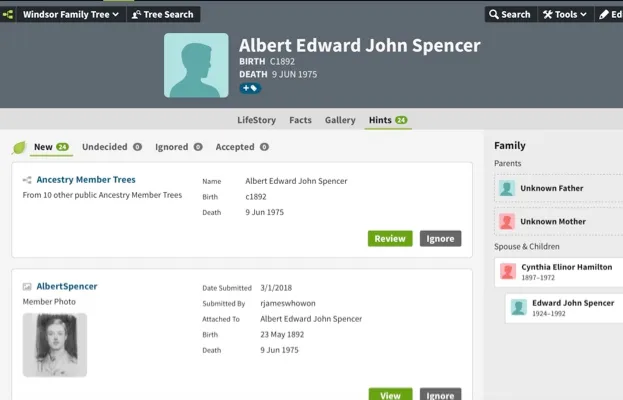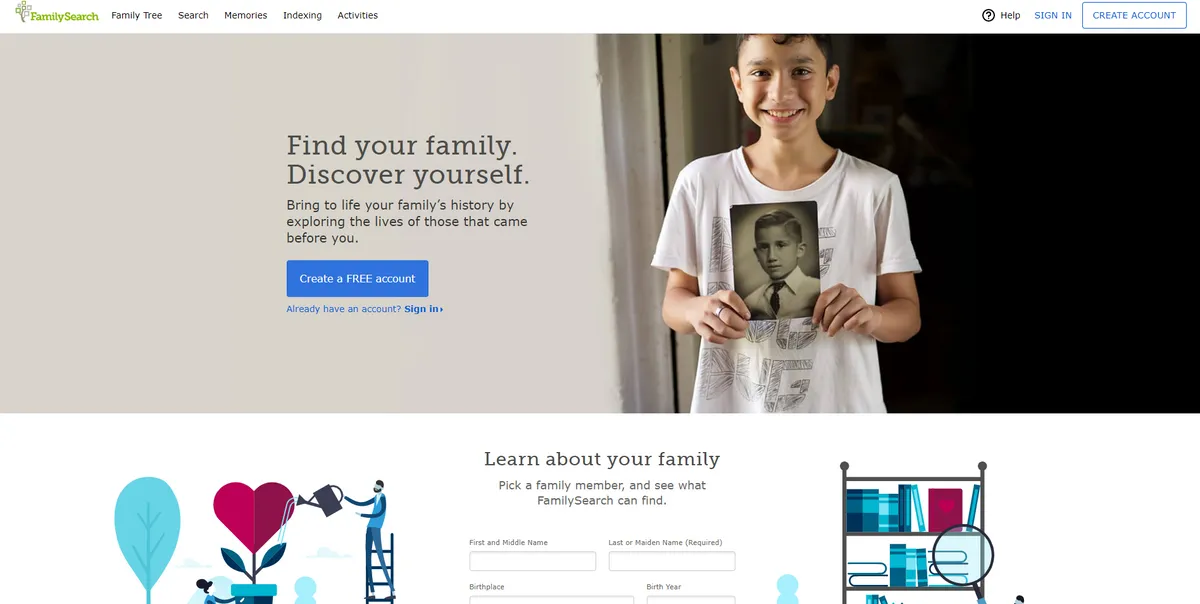Welcome to week two of our #lockdownchallenge to uncover your family’s history.
Last week I encouraged you to set up a free account on Ancestry so that you could start adding details about your family. The task last week was to talk to family members and find out what they know already. This is a process that should continue throughout your research. Sometimes a discovery you make in the records might prompt a memory. Plus, it’s nice to share your progress with others.
At this stage, your family tree might look a bit like this:

How the royal family tree might look on Ancestry
Of course, you may have flown back generations or not got further than your parents, but you should certainly have some names on your tree. You should start to notice a green leaf appear in the top right-hand corner of at least some of your entries. This leaf is Ancestry’s way of saying that they have found some information that may match this person. They call them hints and they will play an important part in building your tree.
The first thing you have to keep in mind with ‘hints’ is that they are just best guesses based on an algorithm that Ancestry uses. It is up to you to check which of the hints relate to your ancestor, which don’t and which might relate to them but you are not yet sure (in which case assign them to the ‘maybe’ folder). In family history it is worth erring on the side of caution. You don’t want to waste time adding people to your tree only to find later that they have nothing to do with your family.

Ancestry supplies 'hints' for your ancestors
You may also start to get additions to your tree suggested by Ancestry as ‘Potential mother’ or ‘Potential father’. These hints are based on matching your tree to other people’s trees. If, when you started on your tree, you chose to keep your tree completely private, you will not see these hints. Even with a free account, you can choose to accept these hints and have these people added to your tree. Remember though that these trees could have errors in them. If you add people this way, try to confirm the facts at a later date.
Click on a green leaf and it will take you straight to that person’s hints. These are made up of records from Ancestry’s collection and information that has been gleaned from other people’s trees. Although Ancestry hints are a quick and easy way to grow your tree, errors can proliferate, especially if you start taking all your information from other people’s trees. Don’t assume that they have done the research, they might just as easily have copied it from another tree that also had an error in it.
You will notice if you click on a record hint that it will take you to a page offering you a subscription. I realise that some of you may have already taken Ancestry up on the offer and will be adding documents to ancestors left, right and centre. However, I also realise that there are plenty of people out there trying to keep their spending to a minimum, so for those people I would suggest holding off for another week.
You can still use the hints to grow your family tree for free. If a birth or death record is suggested as part of the England & Wales, Civil Registration collection, you can search the indexes on the General Register Office for free (although you will have to register). For marriages, try FreeBMD.
If a record comes up from the England & Wales, National Probate Calendar collection, you can use that information to check the record for free at Find a Will.
Another useful free website is FamilySearch. Run by the Church of Latter Day Saints (aka the Mormons), it is the world’s largest family history website and is completely free. If you see census records amongst your hints, you can find transcriptions, although not always images, by using the FamilySearch website. TheGenealogist is also currently offering free access to the 1911 census.

FamilySearch is the world's largest free family history website
Also, if you aren’t a member of your local library yet, many of them have set up simple online ways to join and get a library card during lockdown. Most libraries now offer access to some really useful online resources that you can access from your home including The Times Archive and British Library 19th century newspapers.
So your challenge this week is to work through your Ancestry hints. If you have decided to take up a subscription then accepting hints is easy and you can easily attach them to the person on your tree. Likewise, hints that come from other people’s trees, including ‘Potential relative’ hints can also be added to your tree at the click of a button (even with a free account).
Otherwise, take the hints as a stepping stone and check out some of the free resources mentioned above. We are also keeping a page updated with freebies that are being offered by various genealogy websites during lockdown.
Next week I’ll be answering any questions you may have about your research with tips on breaking down brick walls.
Send your questions to sarah.williams@immediate.co.uk and I will pick as many as possible to answer. Happy hunting and stay safe.